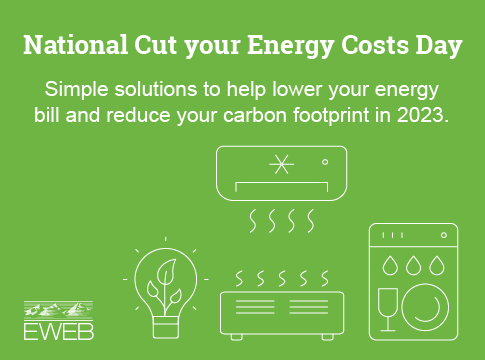With the start of a brand-new year, now is the perfect time to examine our lives and see where we can implement change. Rather than going down the path of a traditional resolution that’s hard to stick with, like working out every day or never having a piece of chocolate again, may we suggest a few sustainable changes for your consideration? The easiest resolutions to keep are the ones that don’t take a lot of effort. So today, in honor of National Cut Your Energy Costs Day, we want to discuss ways you can make easy changes to save energy. And saving energy can help with other personal goals too, like saving money, creating a healthier lifestyle, and helping the planet.
Easy actions you can take today:
- Change your lightbulbs. Making the switch to LED bulbs is one of the easiest ways you can save energy. It is quick and inexpensive. LED lightbulbs use less power, saving you money on your energy bill. They can also last up to 40 times longer than a standard incandescent bulb, saving you money on your household maintenance expenses.
Want to take it a step further? Most major manufacturers produce smart bulbs that can be programmed to a schedule. Now, you no longer have to worry about turning off exterior lights or coming home to a dark house. You can even turn lights off or on while away from your home with a quick touch of a button in their app.
If you are looking to upgrade the lights in your business, check out EWEB’s Commercial Lighting Rebate. Our program helps our business customers improve their lighting and save money.
- Program your thermostat and walk away. Having a programmable thermostat is another easy switch you can make to save energy and money.
Did you know that how you set your thermostat depends on your heating system? For all systems, we recommend setting set your thermostat to 68 degrees or lower in the winter. f this feels chilly, pull on a sweater and slippers before increasing the heat. This may also be a sign you need to weatherize your home. Check for drafts around doors and windows. If you feel cold air, add weather stripping or caulking to seal any gaps. EWEB offers rebates on insulation, air sealing and window replacement as well.
In the warmer months, keep your thermostat at 78 degrees. Every degree that you raise or lower your temperature can raise your energy use by as much as 3%. Check out these additional tips on how to stay cool while reducing energy use in warmer months.
- Use your dishwasher – if you have one. Washing by hand can waste water and energy, depending on the model of dishwasher you have. Did you know washing dishes by hand uses up to 27 gallons of water per load while an Energy Star model dishwasher uses as little as 3 gallons? If your dishwasher has an Energy Star label then it meets strict energy efficiency standards and, on average, uses 12% less energy and 30% less water than a standard model.
You may be wondering how using a dishwasher saves on energy. Consider the temperature of the water. If you are using hot water, then your water heater is going to be working to heat the water. A newer model dishwasher has a heater built in that warms water more efficiently than your household water heater. And remember, even if you don’t have the newest Energy Star model, you are still using less water than handwashing, so less water will be required to be heated. It takes a lot of energy to heat water, it’s the second largest use of energy in the average home. Here are more ways you can use less hot water.
A few other tips – don’t rinse your dishes before sticking them in the dishwasher. Just scrape the big things off. Run full loads only – you can load your dishes and use the rinse cycle if you don’t have a full load yet to wash and want to avoid food sticking to dishes. Air dry your dishes – most dishwashers have the option to turn off heated dry which will circulate cool air instead. Take it a step further and prop open the door of your washer once the wash cycle is done to save even more energy.
- Invest in Lead Green programs. If you are doing all you can to be energy efficient and lower your carbon footprint, but want to do more, consider investing in Lead Green programs. These programs support clean, sustainable energy and encourage renewable energy projects in the local community.
- Carbon Offsets: Neutralize your carbon footprint while supporting the reduction of greenhouse gas emissions and the increase in carbon storage for as little as $1.25 a month.
- Greenpower: Support local rooftop solar projects, for as little as $1.50 a month
- Carbon Forestry Lab: Support the research of carbon sequestration and storage while also enhancing the McKenzie Watershed for as little as $6.50 a month.
- Cleanpower: support the development of new wind, solar and other renewable energy sources by purchasing Renewable Energy Certificates (RECs) for as little as $23.75 a month.
Lifestyle changes to reduce your carbon footprint:
- Move your body! Choose to walk or ride a bicycle when going short distances. Over half (53%) of Eugene’s greenhouse gas emissions come from gas or diesel-powered vehicles. By choosing an alternative transportation method you’ll be saving money at the pump and getting some exercise into your day.
Here are a few tips to consider if you must use a gas-powered vehicle:
-
- Combine errands into one trip, saving time and money. Short trips can use twice as much fuel as a longer multi-purpose trip.
- Reduce excess weight from inside the car. Extra weight reduces mileage, especially on inclines.
- Carpool when possible.
- Air dry your clothes. Around 10% of a home’s total energy use goes to washing and drying clothes, so take a cue from our ancestors and hang your laundry to dry. Switching to air drying can reduce your household’s carbon footprint by 2,400 pounds a year. There are additional benefits to air drying over machine, including extending the lifetime of your clothes, thus saving you money on replacing them, and reducing the risk of a dryer vent fire. Here in the Pacific Northwest the weather can make it challenging to air dry outside, consider an indoor rack.
- Upgrade household appliances or technologies. If your water heater, HVAC, or windows are outdated and in need of replacing, consider newer, more energy efficient models when upgrading. EWEB offers rebates on several home improvements that will increase your energy efficiency.
- Learn more about your carbon footprint and how to reduce it by using a carbon footprint calculator.






